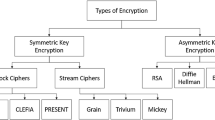Abstract
A video encryption scheme combining with advanced video coding (AVC) is presented and analyzed in this paper, which is different from the ones used in MPEG1/2 video encryption. In the proposed scheme, the intra-prediction mode and motion vector difference are encrypted with the length-kept encryption algorithm (LKE) in order to keep the format compliance, and the residue data of the macroblocks are encrypted with the residue data encryption algorithm (RDE) in order to keep low cost. Additionally, a key distribution scheme is proposed to keep the robustness to transmission errors, which assigns sub-keys to different frames or slices independently. The encryption scheme’s security, time efficiency and error robustness are analyzed in detail. Experimental results show that the encryption scheme keeps file format unchanged, is secure against replacement attacks, is efficient in computing, and is robust to some transmission errors. These properties make it a suitable choice for real-time applications, such as secure IPTV, secure videoconference or mobile/wireless multimedia, etc.
Similar content being viewed by others
References
Access control system for the MAC/packet family: EUROCRYPT (1992) European Standard EN 50094, CENELEC, December
Ahn J, Shim H, Jeon B, Choi I (2004) Digital video scrambling method using intra prediction mode. PCM2004, Springer, LNCS 3333, pp 386–393 (November)
Chiaraluce F, Ciccarelli L, Gambi E, Pierleoni P, Reginelli M (2002) A new chaotic algorithm for video encryption. IEEE Trans Consum Electron 48(4):838–844 (November)
Federal Information Processing Standards Publication (FIPS PUB) 140-1 (1994) Security requirements for cryptographic modules. US Department of Commerce
ITU-T Rec. H.264/ISO/IEC 11496-10 (2002) Advanced video coding. Final Committee Draft, Document JVT-E022, September
Kudelski A (1994) Method for scrambling and unscrambling a video signal. United States Patent 5375168 (20 December)
Lian S, Sun J, Zhang D, Wang, Z (2004) A selective image encryption scheme based on JPEG2000 codec. 2004 Pacific-Rim Conference on Multimedia (PCM2004), Springer LNCS 3332, pp 65–72
Li S, Li C, Chen G, Bourbakis NG (2004) A general cryptanalysis of permutation-only multimedia encryption algorithms. IACR’s Cryptology ePrint Archive: Report 2004/374
Maniccam SS, Bourbakis NG (2004) Image and video encryption using SCAN patterns. Pattern Recogn 37(4):725–737
Mollin RA (2006) An introduction to cryptography. CRC, Florida
Podesser M, Schmidt HP, Uhl A (2002) Selective bitplane encryption for secure transmission of image data in mobile environments. CD-ROM Proceedings of the 5th IEEE Nordic Signal Processing Symposium (NORSIG 2002), Tromso-Trondheim, Norway (October)
Qiao L, Nahrstedt K (1997) A new algorithm for MPEG video encryption. Proceeding of the First International Conference on Imaging Science, Systems and Technology (CISST’97), Las Vegas, Nevada, pp 21–29 (July)
Qiao L, Nahrstedt K, Tam I (1997) Is MPEG encryption by using random list instead of zigzag order secure. IEEE International Symposium on Consumer Electronics, Singapore, pp 226–229 (December)
Iain E G Richardson (2002) H.264/MPEG-4 Part 10, October http://www.vcodex.com
Romeo A, Romdotti G, Mattavelli M, Mlynek D (1999) Cryptosystem architectures for very high throughput multimedia encryption: the RPK solution. International Conference on Electronics, Circuits and Systems (ICECS), Cyprus, pp 261–264
Shi C, Bhargava B (1998) A fast MPEG video encryption algorithm. Proceedings of the 6th ACM International Multimedia Conference, Bristol, UK, pp 81–88 (September)
Shi C, Wang S, Bhargava B (1999) MPEG video encryption in real-time using secret key cryptography. In Proceedings of PDPTA ’99, Las Vegas, Nevada, pp 2822–2828
Shi T, King B, Salama P (2006) Selective encryption for H.264/AVC video coding. Proceedings of SPIE, Vol. 6072, Security, Steganography, and Watermarking of Multimedia Contents VIII, Edward J. Delp III, 607217
Tang L (1996) Methods for encrypting and decrypting MPEG video data efficiently. Proceedings of the Fourth ACM International Multimedia Conference (ACM Multimedia ’96), Boston, MA, pp 219–230 (November)
Tosun AS, Feng W (2000) Efficient multi-layer coding and encryption of MPEG video streams. IEEE International Conference on Multimedia and Exposition (I), pp 119–122
Wu C, Jay Kuo CC (2000) Fast encryption methods for audiovisual data confidentiality. In SPIE International Symposia on Information Technologies 2000, Proceedings of SPIE vol. 4209, Boston, MA, USA, pp 284–295 (Nov)
Wu C, Jay Kuo CC (2001) Efficient multimedia encryption via entropy codec design. In SPIE International Symposium on Electronic Imaging 2001, Proceedings of SPIE vol. 4314, San Jose, CA, USA, pp 128–138 (Jan)
Yen J-C, Guo J-I (1999) A new MPEG encryption system and its VLSI architecture. IEEE Workshop on Signal Processing System, Taipei, pp 430–437
Zeng W, Lei S (2003) Efficient frequency domain selective scrambling of digital video. IEEE Trans Multimed 5(1):118–129
Author information
Authors and Affiliations
Corresponding author
Rights and permissions
About this article
Cite this article
Lian, S., Sun, J., Liu, G. et al. Efficient video encryption scheme based on advanced video coding. Multimed Tools Appl 38, 75–89 (2008). https://doi.org/10.1007/s11042-007-0150-7
Published:
Issue Date:
DOI: https://doi.org/10.1007/s11042-007-0150-7




